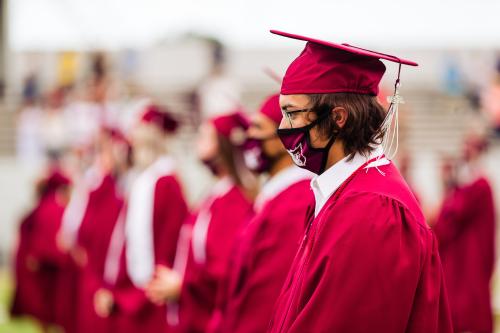In 1972, when the U.S. government passed the landmark Title IX laws to promote gender equality in education, there was a 12 percentage-point gap in the proportion of bachelor’s degrees going to men compared to women. By 1982, the gap had closed. Nobody predicted what happened next: the gap started to widen rapidly in the opposite direction. By 2019, the gender gap in bachelor awards was wider, at 14 points, than it had been in 1972 — but the other way round. (We are not claiming here that Title IX had much impact, however).
Similar trends can be seen in every stage of the education system, and in almost every country in the world. Carol Frances, the former Chief Economist at the American Council on Education, describes it as “phenomenal,” “surging,” and “spectacular.” Stephan Vincent-Lancrin, senior analyst at the OECD’s Centre for Educational Research and Innovation, says it is “astonishing…people can’t believe it.” To Hanna Rosin, author of The End of Men, it is “the strangest and most profound change of the century, even more so because it is unfolding in a similar way pretty much all over the world.”
Importantly, there is a gender gap not only in rates of college enrollment, as we described earlier in the year, and recently highlighted in the Wall Street Journal and The Atlantic, but also in rates of completion among those who do enroll.
College enrollment is falling, mostly among men
Enrollment rates over the past decade are declining, a change almost entirely driven by men. Women are now much more likely to enroll in college than men, and the gender gap widened significantly in 2020. Figure 1 shows the number of students enrolling in college (represented by bars) and the percent change in enrollment rate from the previous year (represented by lines) by sex.

College enrollment has steadily declined following the Great Recession, with total enrollment among both men and women decreasing each year from 2012 to 2020. But many more women than men were enrolling in college when rates began to fall in 2012 (11.6 million women were enrolled at the time, compared to 8.6 million men). If the relative decline among men and women had been similar, we would expect the gender gap in enrollment rates to remain constant. Instead, the fall 2020 decline in male enrollment eclipsed the decline in female enrollment for the fifth year in a row and the gender gap in enrollment is widening. COVID-19 accelerated this trend.
Total first-time student enrollment was 13% lower in fall 2020 than in fall 2019. The decline seems to have been driven largely by a drop in total male enrollment, which was over seven times larger than the drop in female enrollment (-5.1% and -0.7%, respectively). Male students now make up a smaller share of all enrolled students in the United States than ever before — just 41% of students enrolled in a postsecondary institution in fall 2020 were men.
Women graduate high school and college at higher rates
The gap in college enrollment is now getting overdue attention. But this is just one part of the story. Men are also less likely to graduate high school in the first place and less likely to complete college after enrolling. The ten percentage point gap in four-year college enrollment is only compounded by the gap in college completion rates. Figure 2 shows the graduation rates for high school, two-year college, and four-year college by sex and time to complete degree. Note that data shown represent the most recent cohorts for which data are available and are not necessarily comparable across categories. For example, two-year college completion rates (those who receive an associate degree or certificate from their initial institution of attendance) are based on the cohort of students who first enrolled in 2016 and the four-year college completion rates are based on the cohort who first enrolled in 2013. All four-year college completion rates are based on the 2013 entry cohort.

At every level, men are graduating at lower rates than women. Men who enrolled in a four-year college in 2013 were ten percentage points less likely than women to graduate within 4 years. Six years after enrolling, the gender gap in graduation narrows to six percentage points. Six-year college completion rates have modestly increased among both men and women over the past decade, but the gender gap has remained about the same.
With men less likely to enroll and graduate conditional on enrollment, it is no surprise that there are big gaps in the college degree attainment in the adult population, especially in younger cohorts. Figure 3 shows the portion of degrees conferred to men by level.
Over 1.1 million women received a bachelor’s degree in the 2018-19 academic year compared to fewer than 860,000 men; put differently, about 74 men received a bachelor’s degree for every 100 women. Even fewer men graduate with an associate or master’s degree, relative to women. Doctoral degree conferral is the most gender-balanced, though even here 54% of degrees are conferred to women. Although women are more likely to graduate college at each level, men are still overrepresented within many fields with high earnings potential, such as engineering or computer science.
Education gaps across the lifecycle
So far, we have focused on the most recent cohorts. But the gender gap wasn’t always this dramatic (or even in this direction). Figure 4 shows the portion of adults with at least a bachelor’s degree in 2019, by sex and age group. Men born from 1955 to 1974 (ages 45-64 in 2019) who likely wrapped up their postsecondary education decades ago, attained bachelor’s and graduate degrees at a similar rate to women in their age group. By contrast, older men born before 1955 had higher educational attainment than women, and younger men born after 1974 seem to be consistently outpaced by women their age.
Among those born before 1955 (ages 65 and over in 2019), men are nine percentage points more likely to have at least a bachelor’s degree than women. This is the only age group for which a traditional gender gap favoring men holds. It is worth noting that women live longer than men on average, so the average age of women over 65 is higher than the average age of men over 65. The gender gap in that age range may therefore appear slightly larger than it would if the age distribution were the same by sex. Among those born between 1985 and 1994 (ages 25 to 34 in 2019), on the other hand, men are eight percentage points less likely to have a bachelor’s degree or higher than women.
A similar trend holds when looking at bachelor’s degree attainment and at graduate or professional degree attainment separately: Men over the age of 65 are four percentage points more likely to have a bachelor’s degree than women and five percentage points more likely to have a graduate or professional degree, whereas men ages 25 to 34 are four percentage points less likely to have a bachelor’s degree than women and four percentage points less likely to have a graduate or professional degree.
Class, gender and the education gap
It is important to underline the fact that socioeconomic and demographic factors strongly influence a student’s decision to attend college, quite apart from gender. For instance, 84% of students from the top income quintile enroll in any college in the fall after high school graduation compared to 72% of students in the middle class and 63% of students in the bottom income quintile. Similarly, white and Asian students are over five percentage points more likely to enroll in any college after high school graduation than their Hispanic and Black counterparts. In future work, we will be investigating the gendered effects of socioeconomic status and race on college enrollment.
The underperformance of boys in the classroom — especially Black boys and those from poorer families — damages their job prospects and their chances for upward economic mobility. But there is also a basic fairness question here. Inequalities of this magnitude are a cause for concern, regardless of their direction. Women’s wages still lag behind men’s, and recent progress on the pay gap has slowed. But inequity in the workplace shouldn’t mean we disregard inequity in classroom, especially when many vulnerable boys are falling behind. We can hold two thoughts in our head at the same time.
Closing the gender gap in education will require interventions every step of the way. College enrollment is important. But it is at least as important to focus on helping male students to complete their college education, preferably within a reasonable time period. Some initiatives specifically focused on male students should be on the table.
The Brookings Institution is financed through the support of a diverse array of foundations, corporations, governments, individuals, as well as an endowment. A list of donors can be found in our annual reports published online here. The findings, interpretations, and conclusions in this report are solely those of its author(s) and are not influenced by any donation.








Commentary
The male college crisis is not just in enrollment, but completion
October 8, 2021